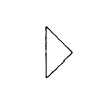| |
PREPARING A FLOW
PROCESS CHART
A flow process chart, either a Single-Column
Flow Process Chart, NAVPERS 594, or a local
form, can help you to analyze your work flow.
You can prepare a flow process chart for any pro-
cess, person, or material you wish to analyze.
The heading of the chart indicates what aspect
of the operation you are analyzing and where
the process begins and ends. You should then
list the steps that are involved in the pro-
cess in the sequence in which the steps occur
under your present method. (Figure 3-5 illustrates
a method that is currently being used for
handling the breakout of a ship’s store stock.)
Next, you should draw a line to connect the
symbols that identify what each step involves.
The five symbols are explained in the following
paragraphs.
Operation—An operation rep-
resents a main step in the
process and takes place when
something is being created,
changed, added to, or pre-
pared for another step. An
operation also occurs when information
is given or received. Some examples of an
operation are the preparation of a breakout
document (NAVSUP 973), receipt of ship’s
store stock into the bulk storeroom, or the
sale of an item of merchandise in the ship’s
store.
Transportation—Transporta-
tion is an auxiliary step that
occurs when something is
moved from one place to
another,
except when such
movement is part of an opera-
tion or inspection. Some examples of transporta-
tion are a document that is being carried to
another location or a person who is moving to
another area of the ship.
Inspection—An inspection is
an auxiliary step that occurs
when items are checked,
verified, reviewed, or ex-
amined for quality or quantity.
However, the items inspected
are not changed at this point. Some examples
of inspection are proofreading a letter, checking
a breakout document for proper signatures,
or verifying that a customer’s change is
correct.
Delay—A delay is an auxiliary
step that occurs when condi-
tions do not permit or require
an immediate performance of
the next step. Some examples
of a delay are a document
that is waiting for a signature and a customer
who is waiting in line at the ship’s store.
Storage—Storage occurs when
something remains in one
place and is not being worked
on in a regular process, or
is awaiting further action at
a later date. Some examples
of storage are a document that is held in
a file for later forwarding with returns and
ship’s store stock that is stowed in a store-
room.
USING FLOW PROCESS CHARTS
In analyzing a flow process chart, you can
determine the actions you must take to improve
the sequence of any operation by asking yourself
Who?, What?, When?, Where?, Why?, and
How? You should make notes relating to these
questions on the chart that represents your pres-
ent method of work flow (fig. 3-5). You will use
these notes for the development of a revised chart
that will represent a proposed method of work
flow. Figure 3-6 shows a revised chart that has
been developed from the present method chart
shown in figure 3-5. You can apply flow process
charting effectively to solve procedural problems
created by changes in your personnel, your
organization, or your volume of work; to review
your operating methods periodically; and to
establish new organizations.
A resale operation, such as the prepara-
tion and processing of a breakout document,
the movement of merchandise during receipt,
or a cash-handling procedure are all work
flow situations that you can analyze by using
a flow process chart. Even if you decide
against using an actual chart, you can still
improve the sequence of operations in any
work flow situation by asking yourself the
questions: Who?, What?, Where?, When?,
Why?, and How?
An office operation can be analyzed in a
similar manner. To discover any possible delays
3-8
|





